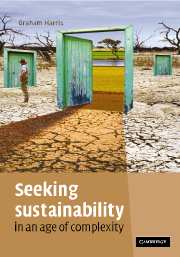Book contents
- Frontmatter
- Contents
- Acknowledgements
- 1 Preamble: the world we are in
- 2 Complexity and complex systems
- 3 New science, new tools, new challenges
- 4 The complexity of ecology
- 5 The generation of complexity
- 6 Micro-interactions and macro-constraints
- 7 A sense of place
- 8 Created landscapes and our changing sense of place
- 9 Catchment form and function
- 10 Catchment loads: ecosystem impacts
- 11 Change detection, monitoring and prediction
- 12 Evidence, uncertainty and risk
- 13 Modified landscapes: biodiversity
- 14 Function in fragmented landscapes
- 15 Environmental flows
- 16 Evidence for global change
- 17 Values and beliefs
- 18 Managing environmental, social and economic systems
- 19 Linking multiple capitals in a changing world
- 20 Community, capacity, collaboration and innovation
- 21 A new environmental paradigm
- 22 Emergent problems and emerging solutions: developing an ‘ecolophysics’?
- 23 Avoiding collapse
- Index
15 - Environmental flows
Published online by Cambridge University Press: 21 March 2011
- Frontmatter
- Contents
- Acknowledgements
- 1 Preamble: the world we are in
- 2 Complexity and complex systems
- 3 New science, new tools, new challenges
- 4 The complexity of ecology
- 5 The generation of complexity
- 6 Micro-interactions and macro-constraints
- 7 A sense of place
- 8 Created landscapes and our changing sense of place
- 9 Catchment form and function
- 10 Catchment loads: ecosystem impacts
- 11 Change detection, monitoring and prediction
- 12 Evidence, uncertainty and risk
- 13 Modified landscapes: biodiversity
- 14 Function in fragmented landscapes
- 15 Environmental flows
- 16 Evidence for global change
- 17 Values and beliefs
- 18 Managing environmental, social and economic systems
- 19 Linking multiple capitals in a changing world
- 20 Community, capacity, collaboration and innovation
- 21 A new environmental paradigm
- 22 Emergent problems and emerging solutions: developing an ‘ecolophysics’?
- 23 Avoiding collapse
- Index
Summary
The development of decision support systems in the ill-defined and uncertain world of landscapes, rivers and modified flow regimes.
As we move towards regional landscape and waterscape management, and as we attempt to find new land use mosaics and systems operation protocols to more closely mimic the world of ‘the rest of nature’, there is an increasing focus on what are called ‘environmental flows’: the water requirements of the aquatic ecosystems of our rivers and estuaries. The ‘environmental flows problem’ is a particularly revealing example of all the problems we have discussed so far: complexity of interactions within catchments, uncertainty, the lack of discriminating indicators and problems with linking indicators to management recommendations. Some of the more innovative solutions are also indicative of trends in natural resource management.
Agricultural and urban developments cause alterations to the natural flow regimes of rivers and estuaries through diversions, dams and water extraction as well as changed runoff characteristics. As we have seen, this is now a massive, worldwide problem. The flows in most of the world's major rivers are regulated to some degree. In addition, water quality is reduced through leakage and wash-off of nutrients from soils, crops and urban areas. Water quality is also reduced because of waste disposal and waste water discharges of various kinds. In Western countries considerable progress has been made in reducing nutrients and pollutants in what are called point source discharges (sewage overflows, waste water discharges and industrial waste streams) through improved treatment technologies and regulation.
- Type
- Chapter
- Information
- Seeking Sustainability in an Age of Complexity , pp. 204 - 218Publisher: Cambridge University PressPrint publication year: 2007

